Books
Books
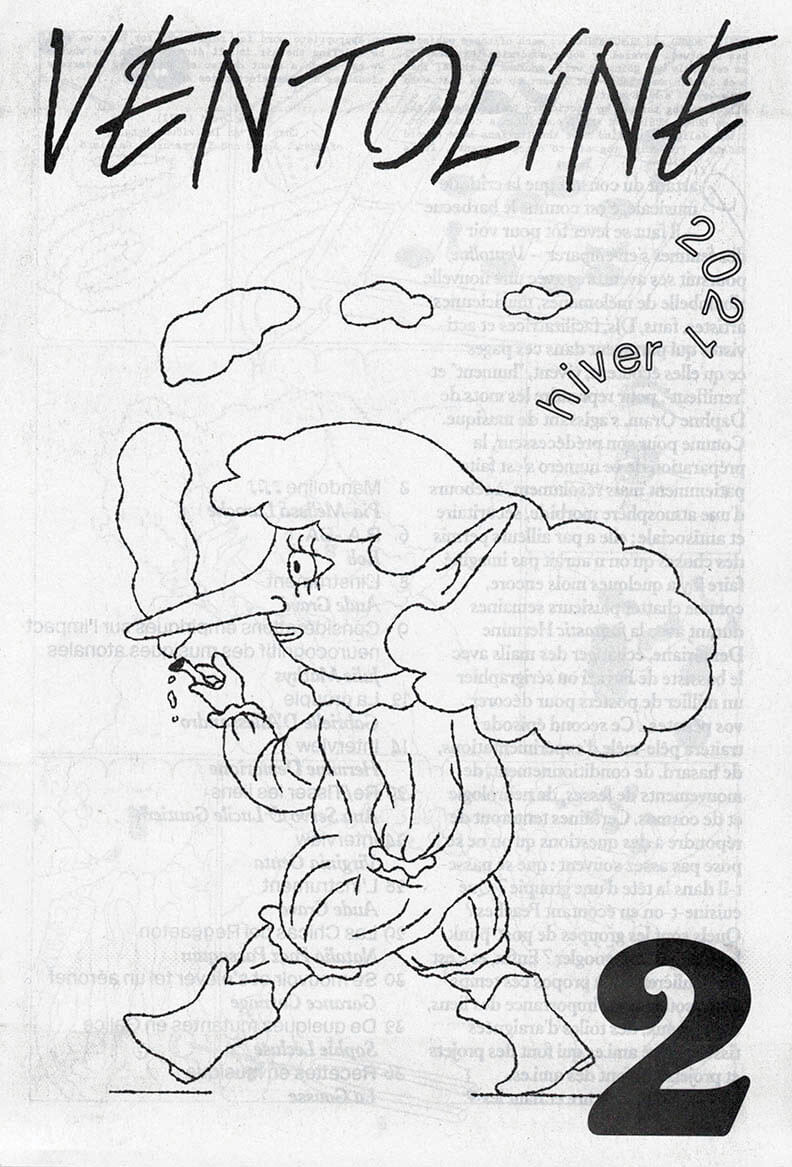
Ventoline #2 – hiver 2021
Partant du constat que la critique musicale, c’est comme le barbecue — il faut se lever tôt pour voir des femmes s’en emparer — Ventoline poursuit ses aventures avec une nouvelle ribambelle de mélomanes, musiciennes, artistes, fans, DJs, facilitatrices et activistes qui partagent dans ces pages ce qu’elles écoutent, vivent, « hument » et « reniflent », pour reprendre les mots de Daphne Oram, s’agissant de musique. Comme pour son prédécesseur, la préparation de ce numéro s’est faite patiemment mais résolument, à rebours d’une atmosphère morbide, sécuritaire et antisociale ; elle a par ailleurs permis des choses qu’on n’aurait pas imaginé faire il y a quelques mois encore, comme chatter plusieurs semaines durant avec la fantastic Hermine Demoriane, échanger des mails avec le bassiste de Fugazi ou sérigraphier un millier de posters pour décorer vos pénates…
Ce second épisode traitera pêle-mêle d’expérimentations, de hasard, de conditionnement, de mouvements de fesses, de neurologie et de cosmos. Certaines tenteront de répondre à des questions qu’on ne se pose pas assez souvent : que se passe-t-il dans la tête d’une groupie ? Que cuisine-t-on en écoutant Peaches ? Quels sont les groupes de post-punk les plus galère à googler ? Enfin, et c’est particulièrement à propos ces temps-ci, on soulignera l’importance des liens, des réseaux, des toiles d’araignées tissées entre ami.es qui font des projets et projets qui font des ami.es…
(ENG)
Ventoline is a French music zine written and illustrated by women only. The second issue includes contributions by Pia-Mélissa Laroche, Bob Siegrist, Julie Mathys, Gabrielle d'Alessandro, Aude Gravé, Ana Servo, Lucile Gautier, Natalia Paez Passaquin, Garance Carnage, Sophie Lecluse, La Gousse, as well as interviews of Hermine Demoriane and Virginia Genta.
17 x 25 cm, 40 pages printed on newspaper by Newspaper Club ; comes with a screen printed poster by Pia-Mélissa Laroche.
1st edition of 1500 copies, jan. 2021
more on https://ventoline.octavie.club
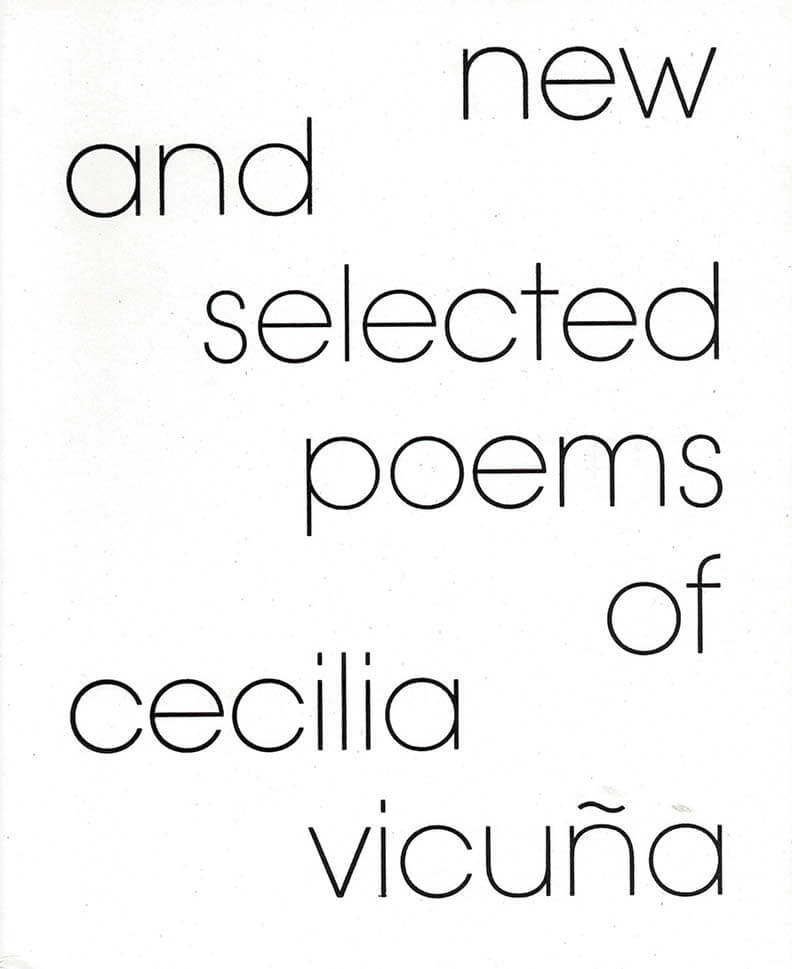
New and Selected Poems of Cecilia Vicuña
New and Selected Poems of Cecilia Vicuña is a telling of old cultures, modern nation states and lives in exile. Rodrigo Toscano calls Vicuña's poetry the outer out, beyond nation states, passed 'inter state' affairs, in other words, close in, as close as we get to our fair planet's sources, and to each other. In this bilingual collection, Vicuña and her translator, Rosa Alcalá, are artist witnesses to a natural world that is a storehouse of sacred words, seeds, threads and songs. Present everywhere, they are sources for a rebalancing in human relationships and for new forms of grace and healing. In Vicuña's vision, art is life and intimacy with it is transformative.
Cecilia Vicuña is a Chilean poet, artist and filmmaker. The author of twenty poetry books published in Europe, Latin America and the U.S., she performs and exhibits her work widely. A precursor of conceptual, impermanent art and the improvisatory oral performance, her work deals with the interactions between language, earth and textiles. Her recent books are NEW AND SELECTED POEMS OF CECILIA VICUÑA (Kelsey Street Press, 2018), SPIT TEMPLE: THE SELECTED PERFORMANCES OF CECILIA VICUÑA (Ugly Duckling Presse, 2012), Chanccani Quipu, a new artist book by Granary Books, and SABORAMI (ChainLinks, 2011). She co-edited The Oxford Book of Latin American Poetry (2009). Since 1980 she divides her time between Chile and New York.
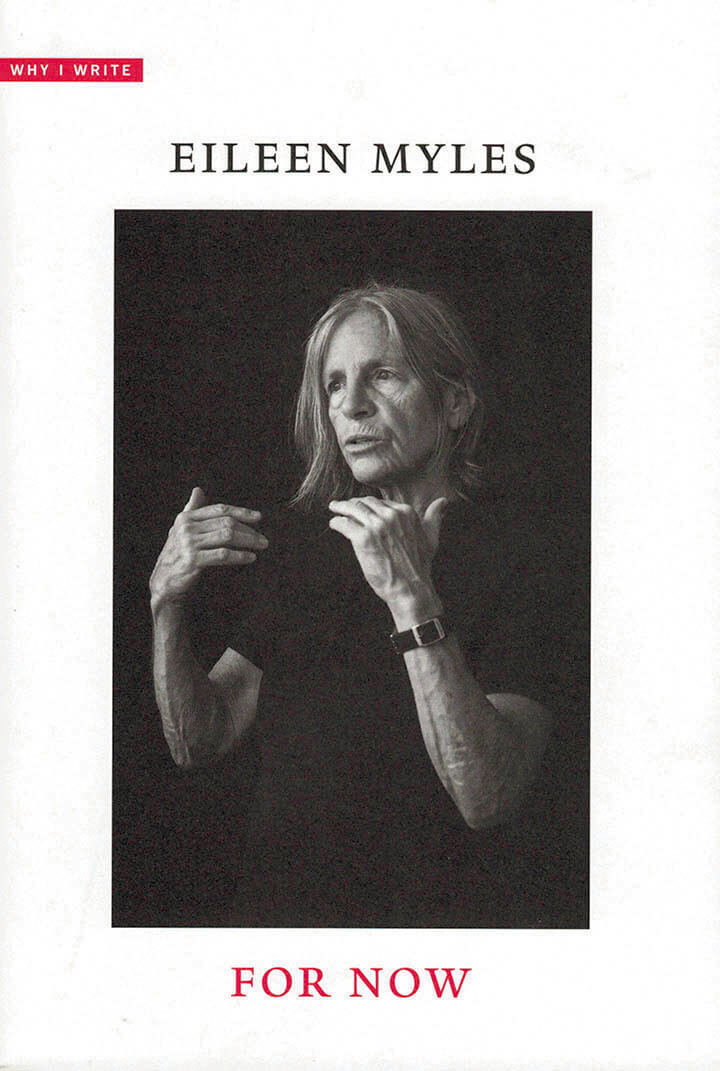
For Now
In this third Why I Write volume, Eileen Myles addresses the social, political, and aesthetic conditions that shape their work.
In this raucous meditation, Eileen Myles offers an intimate glimpse into creativity's immediacy. With erudition and wit, Myles recounts their early years as an awakening writer; existential struggles with landlords; storied moments with neighbors, friends, and lovers; and the textures and identities of cities and the country that reveal the nature of writing as presence in time.
For Myles, time's "optic quality" is what enables writing in the first place, as attention, as devotion, as excess. It is this chronologized vision that enables the writer to love the world as it presently is, lending love a linguistic permanence amid social and political systems that threaten to eradicate it. Irreverent, generous, and always insightful, For Now is a candid record of the creative process from one of our most beloved artists.

1 Million Roses for Angela Davis / 1 Million Rosen für Angela Davis
"1 Million Roses for Angela Davis" traces Davis' immense influence and legacy as activist and scholar on contemporary artists today, while simultaneously teasing out the contradictions her presence and agenda posed to the GDR's interpretation and application of Marxism.
"A Million Roses for Angela Davis" was the motto of a 1970–72 solidarity campaign in East Germany in support of US philosopher, Communist, and Black Power revolutionary Angela Davis, who at the time was being held on terrorism charges in California.
The large-scale movement firmly anchored the "heroine of the other America" within the cultural memory of a now-vanished social utopia, which after her acquittal welcomed her as a state guest. For her part, Davis had hoped for an internationalist movement promoting a socialist, feminist, and non-racist democracy—the antithesis of her experiences of violence and oppression as a Black woman in the United States. This moment of hope provides the historical starting point for the exhibition at the Albertinum in Dresden. The group show features archival materials, historical portraits of Davis by state painters of the GDR, new commissions, and other works by an array of contemporary artists focusing on the issues that the now emeritus professor campaigned for at the time, which are still pressing today. It aspires to initiate discussion on the background, flaws, and unfulfilled potential of the unusual relationship between Davis and the GDR.
The contributions in this accompanying reader unfold how Davis's iconic image came to be inscribed within a global history of resistance, and introduce all of the participating artists with short texts.
"And if we believe that revolutions are possible, then we have to be able to imagine different modes of being, different ways of existing in society, different social relations. In this sense art is crucial. Art is at the forefront of social change. Art often allows us to grasp what we cannot yet understand." —Angela Davis
Works by Yael Bartana, Jean-Michel Basquiat, Sophie Calle, Contemporary And, Sadie Barnette, CHTO DELAT?, Melvin Edwards, Ângela Ferreira, Bernhard Franke, Coco Fusco, Ellen Gallagher, Claudia Martínez Garay, Lawrence Abu Hamdan, Arthur Jafa, Steffani Jemison & Justin Hicks (Mikrokosmos), Iris Kensmil, Hassan Khan, Kapwani Kiwanga, Raja Lubinetzki & Petra Schramm, Julie Mehretu, Heinz-Detlef Moosdorf, Senga Nengudi, Ahmet Öğüt, Slavs and Tatars, Julia Phillips, Alex Martinis Roe, Elske Rosenfeld, Anri Sala, Willi Sitte, Cauleen Smith, Nancy Spero, Gabriele Stötzer, Strawalde (Jürgen Böttcher), Nasan Tur, Lewis Watts, Carrie Mae Weems, Christoph Wetzel, Charles White, Heinz Wodzicka.
Published on the occasion of the eponymous exhibition at Staatliche Kunstsammlungen Dresden, from October 10, 2020 to January 24, 2021.

Programmed Melancholy
Gabriel Abrantes has been making a career in cinema; with numerous international exhibitions, he's been keeping prolific, with video installations, drawing, painting, and now also VR. This book, published by maat and Mousse, attests exactly this. A book that is predominantly visual and clearly structured, efficient in transposing a certain formal and conceptual attitude that runs through Abrantes's work into the book's aesthetic approach, expressing humour and irony visually within a relatively classical framework.
"The juxtaposition of references to art and cultural history with personal and socio-political commentary is a guiding thread throughout Programmed Melancholy." writes Emily Butler, in one of the essays included in this book (other texts are an interview with the artist and short essay by Rosa Lleó). Butler continues: "His works engage with our emotions, with a range of personal feelings, often humorous, potentially rousing ethical and political beliefs. Unstable, multi-faced, polysexual, his characters waver between expressing personal emotions and wider social, environmental and political concerns."
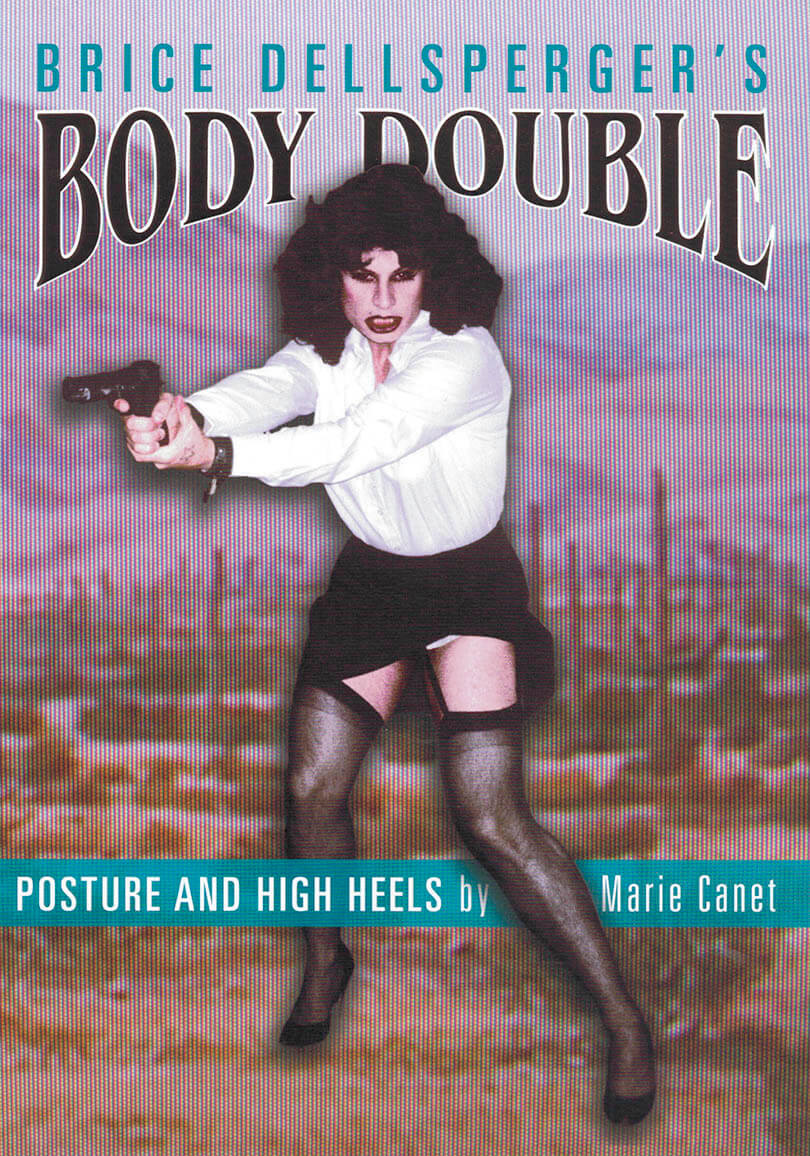
Body Double
Artist's book (an hallucinated portrait gallery of most of the characters created by Brice Dellsperger for his film remakes) / first substantive study of his work, with an essay by Marie Canet.
Brice Dellsperger's Body Double is the first monograph ever published on the artist's already cult film productions, with a long essay by art historian Marie Canet that addresses filmic remake, but also issues of models, gender politics, and representational chaos. Consisting in a large body of unpublished images, the book also invites the reader backstage—as in Kenneth Anger's Hollywood Babylon, after which this book is modeled—into the Dellspergian camp film factory, to get a closer look at the characters and personas that populate the Body Double series, and that are creations both of the artist and of his main performer and muse, Jean-Luc Verna.
Brice Dellsperger (born 1972 in Cannes, France, lives and works in Paris) pushes the boundaries of genre and gender. In his multifaceted reprises of iconic film sequences—all assembled under the generic title Body Double—the cineast and artist reenacts the selected scenes frame for frame and lets his “body doubles” perform all of the roles, be they male or female.
Brice Dellsperger has exhibited extensively in Europe and abroad, and began his well-known Body Double series in 1995. His work is in collections that include the Museum of Modern Art, Musée d'Art Moderne – Centre Pompidou, and the Nouveau Musée National de Monaco.
Available in French edition.
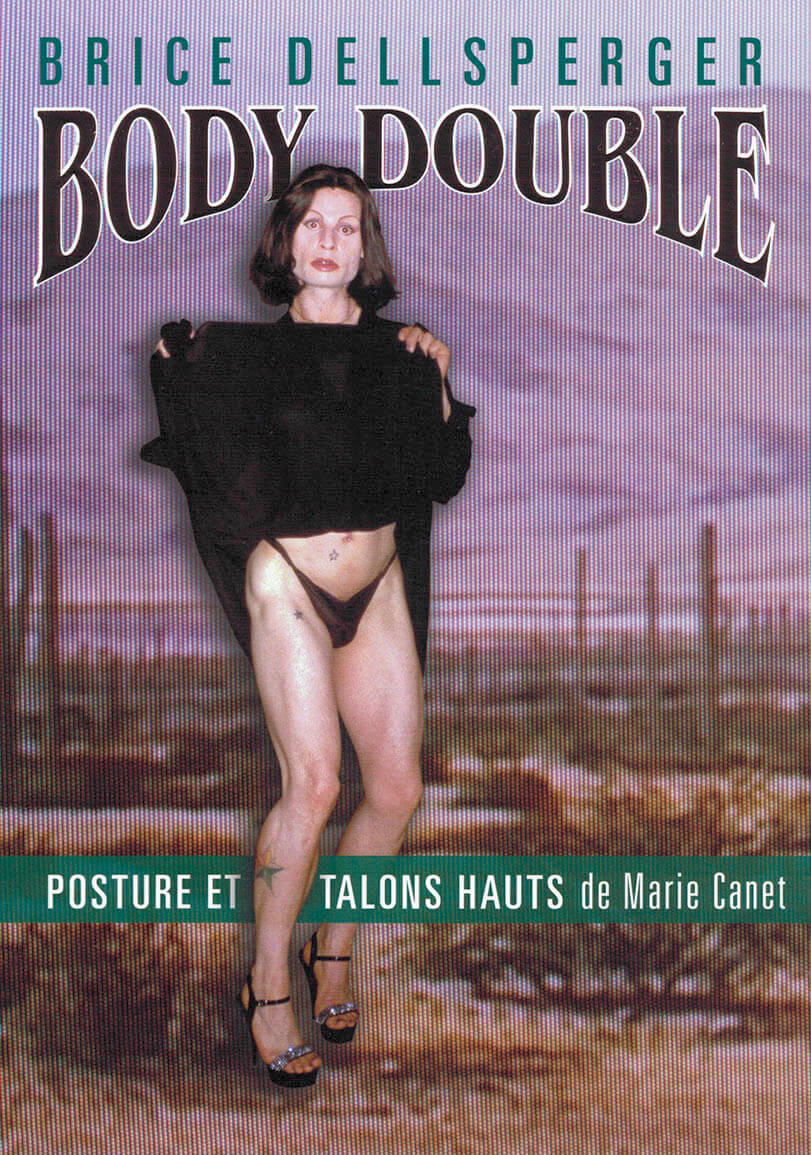
Body Double (French Edition)
Artist's book (an hallucinated portrait gallery of most of the characters created by Brice Dellsperger for his film remakes) / first substantive study of his work, with an essay by Marie Canet.
Brice Dellsperger (born 1972 in Cannes, France, lives and works in Paris) pushes the boundaries of genre and gender. In his multifaceted reprises of iconic film sequences—all assembled under the generic title Body Double—the cineast and artist reenacts the selected scenes frame for frame and lets his “body doubles” perform all of the roles, be they male or female.
Brice Dellsperger has exhibited extensively in Europe and abroad, and began his well-known Body Double series in 1995. His work is in collections that include the Museum of Modern Art, Musée d'Art Moderne – Centre Pompidou, and the Nouveau Musée National de Monaco.
Available in English edition.
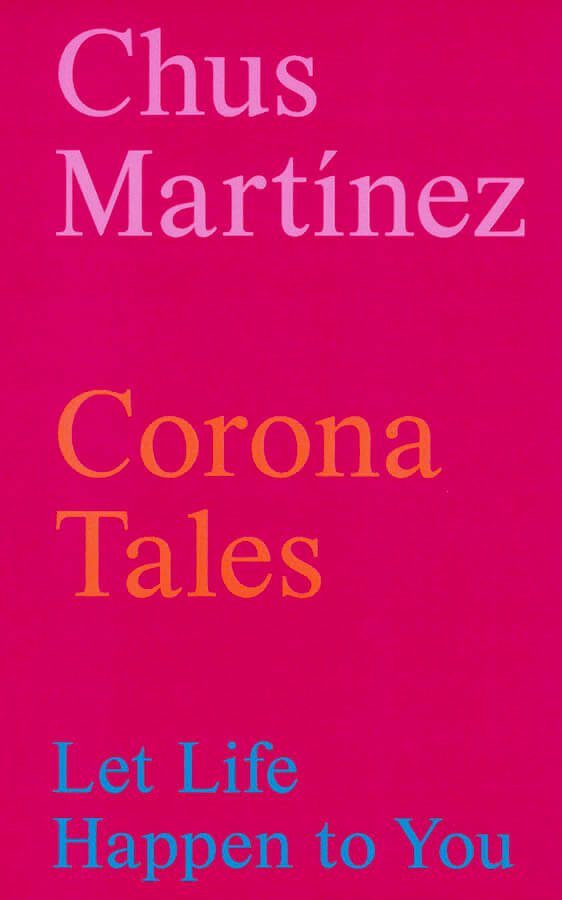
Corona Tales – Let Life Happen to You
When she started writing the Corona Tales, Chus Martínez had been weighing how people and the media were addressing the outbreak of the virus as an unprecedented disaster. One possible contribution, as curator and writer, would be to write a short story a day and post it on an Instagram account that many could access…
Martínez grew up with her grandparents till she was four, and so did her cousin, while both their parents migrated to a big city—hers to Barcelona, his to Basel—to work. The grandparents' childhood was marked by extreme poverty: the Spanish flu left the grandfather orphan of both parents; the grandmother's family, from the same small village in the north west coast of Spain, was also forced to encourage their children to help and work for money. These circumstances were reflected by them—with no trace of sorrow or bitterness.
The recovery was so slow that the author's mother could not afford to attend school and it was only when she married that she and her father enrolled a night course. The stories about these two generations, posted daily, from Basel, around 7pm, offered a chance for gathering, if just virtually, demanding to identify vulnerabilities, how the COVID-19 crisis was being generalized, and how to research ways of doing. Accompanied for the first time in this book by new imagery, they provide tools for reflecting in the past and present tense.
Published December 2020
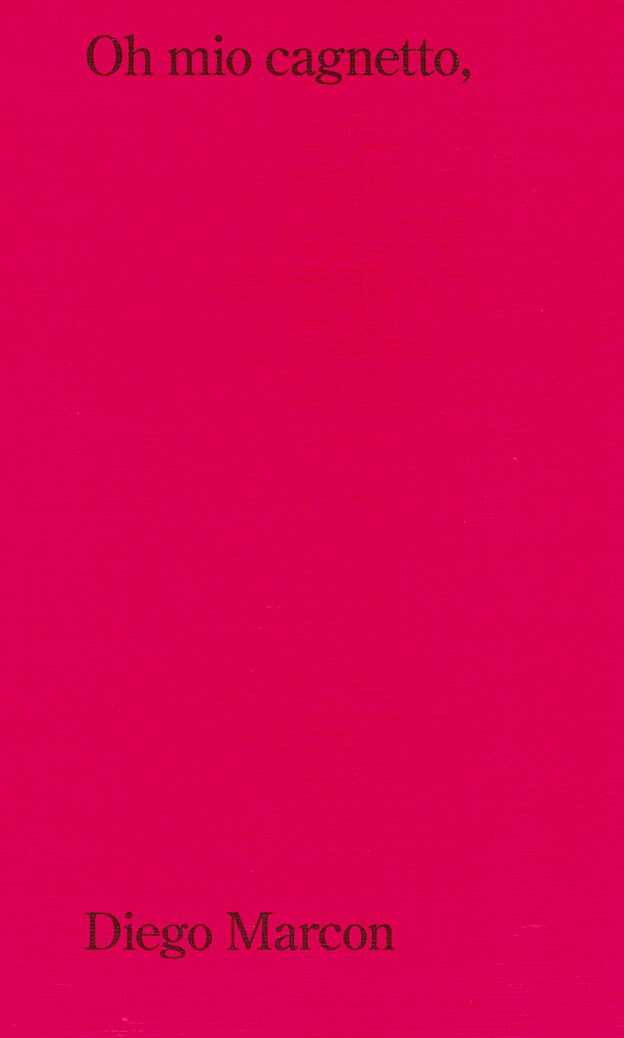
Oh mio cagnetto
Oh mio cagnetto is the artist's first book of writings, conceived as an artwork. It is a collection of 81 little poems that revolve around the missed and mourned figure of a puppy.
These short nursery rhymes all open with the same words and employ the same structure: two rhymed couplets in traditional meter. A seemingly naïve, childish voice speaks of violence, death and grief, yet never slips into pure plaintive lament. Balancing pathos with humor, the poems turn the puppy into a figure that evokes a broader sense of loss.
Oh mio cagnetto, was written between 2018 and 2020 and is now in the collection of MACRO in Rome. It intentionally plays on the ambiguity of its nature, as both a book distributed in conventional ways and an art object that belongs to a museum.
Diego Marcon (born 1985 in Busto Arsizio, Italy, lives and works in Paris) is a visual artist working mostly with film and video.

Blackspace: On the Poetics of an Afrofuture
Black artists of the avant-garde have always defined the future.
Blackspace: On the Poetics of an Afrofuture is the culmination of six years of multidisciplinary research by trans poet and curator Anaïs Duplan about the aesthetic strategies used by experimental artists of color since the 1960s to pursue liberatory possibility. Through a series of lyric essays, interviews with contemporary artists and writers of color, and ekphrastic poetry, Duplan deconstructs how creative people frame their relationships to the word, "liberation." With a focus on creatives who use digital media and language-as-technology, luminaries like Actress, Juliana Huxtable, Lawrence Andrews, Tony Cokes, Sondra Perry, and Nathaniel Mackey, Duplan offers three lenses for thinking about liberation: the personal, the social, and the existential. Arguing that true freedom is impossible without considering all three, the book culminates with a personal essay meditating on the author's own journey of gender transition while writing the book.
Anaïs Duplan is a trans* poet, curator, and artist. He is the founding curator for the Center for Afrofuturist Studies, an artist residency program for artists of color, based in Iowa City. He has worked as an adjunct poetry professor at the University of Iowa, Columbia University, Sarah Lawrence, and St. Joseph's College. He was a 2017-2019 joint Public Programs Fellow at the Museum of Modern Art and the Studio Museum in Harlem.
Published Oct 2020

Shame Space
Diaries of an avatar: a Bible-style artist's book of writings by Martine Syms
A new artist's book by California-based artist Martine Syms (born 1988), Shame Space explores the possibilities of narrative and identity, collecting journal writings by the artist from 2015 to 2017 in which she attempts to capture her shadow self, alongside image stills from the video project Ugly Plymouths. The text entries form the voiceover of Mythiccbeing (pronounced "my thick being'), a "black, upwardly mobile, violent, solipsistic, sociopathic, gender-neutral femme" digital avatar who has iterated across several of Syms' recent exhibitions. In Syms' installations, Mythiccbeing manifests variously in video, audio and as an interactive chatbot that responds to the viewer's communications with messages and animations.
In Shame Space, the character's autofictional, diaristic commentary is gathered into 15 chapters. Its design updates the Bible format with its A5 size, embossed leather-textured cover and silver edge painting. The Ugly Plymouths still-image selection was coded using a programming script, such that the design, like the chatbot's SMS responses, is an exercise in machine automation.
Published Dec 2020

Homie
Homie is Danez Smith’s magnificent anthem about the saving grace of friendship. Rooted in the loss of one of Smith’s close friends, this book comes out of the search for joy and intimacy within a nation where both can seem scarce and getting scarcer. In poems of rare power and generosity, Smith acknowledges that in a country overrun by violence, xenophobia, and disparity, and in a body defined by race, queerness, and diagnosis, it can be hard to survive, even harder to remember reasons for living. But then the phone lights up, or a shout comes up to the window, and family—blood and chosen—arrives with just the right food and some redemption.
Part friendship diary, part bright elegy, part war cry, Homie is the exuberant new book written for Danez and for Danez’s friends and for you and for yours.
& colin kaepernick is my president, who kneels on the air
bent toward a branch, throwing apples down to the children
& vets & rihanna is my president, walking out of global summitswith wine glass in hand, our taxes returned in goldto dust our faces into coins
& my mama is my president, her grace stuntson amazing, brown hands breaking brown bread overmouths of the hungry until there are none unfed & my grandma is my president
& her cabinet is her cabinetcause she knows to trust what the pan knowshow the skillet wins the war
—from “my president”

A Documentary Herstory of Women Artists in Revolution
A rare, ever-relevant compendium of texts and manifestos from women artists on gender and race issues in cultural institutions
Originally published in 1971, A Documentary HerStory of Women Artists in Revolution documents the efforts of W.A.R., a loose group of women artists, filmmakers, writers and cultural workers organized around advancing the place of women in the art world. Members of W.A.R. included Juliette Gordon, Sara Saporta, Therese Schwartz, Muriel Castanis, Cindy Nemser, Dolores Holmes, Betsy Jones, Silvia Goldsmith, Jan McDevitt, Lucy Lippard, Grace Glueck, Poppy Johnson, Brenda Miller, Faith Ringgold, Emily Genauer, Agnes Denes, Doloris O'Kane and Jacqueline Skiles.
Active from 1969 to 1971, W.A.R. was founded as the women's caucus of the Art Workers' Coalition (AWC). AWC mobilized around anti-war protest and anti-racist action, also campaigning for artists' rights and wages, the decentralization of museums across NYC boroughs, more diverse exhibition programming and the restructuring of management within cultural institutions.
This facsimile publication of A Documentary HerStory of Women Artists in Revolution gathers manifestos, statements and declarations by W.A.R. members; articles and reports about gendered and racialized discrimination in the arts; pro-abortion flyers and protest ephemera; and grant applications and reports detailing the founding of the Women's Interart Center in spring 1970, W.A.R.'s brick-and-mortar studio, workshop and exhibition space. It also reproduces documentation of key actions including the 1970 Art Strike Against Racism, Sexism, Repression and War, and correspondence with officials at the Whitney Museum, the Guggenheim Foundation and the Museum of Modern Art, among others.
This publication takes as its source the second edition of the publication, which was published in 1973. The edition was chosen because it features a preface and addendum with retrospective reflections on the history and activities of W.A.R.
Published January 2021

Columbia Books on Architecture and the City
Paths to Prison: On the Architectures of Carcerality
As Angela Y. Davis has proposed, the "path to prison," which so disproportionately affects communities of color, is most acutely guided by the conditions of daily life. Architecture, then, as fundamental to shaping these conditions of civil existence, must be interrogated for its involvement along this diffuse and mobile path. Paths to Prison: On the Architectures of Carcerality aims to expand the ways the built environment's relationship to and participation in the carceral state is understood in architecture. The collected essays in this book implicate architecture in the more longstanding and pervasive legacies of racialized coercion in the United States—and follow the premise that to understand how the prison enacts its violence in the present one must shift the epistemological frame elsewhere: to places, discourses, and narratives assumed to be outside of the sphere of incarceration.
Paths to Prison: On the Architectures of Carcerality offers not a fixed or inexorable account of how things are but rather a set of starting points and methodologies for reevaluating the architecture of carceral society and for undoing it altogether.
With contributions by Adrienne Brown, Stephen Dillon, Jarrett M. Drake, Sable Elyse Smith, James Graham, Leslie Lodwick, Dylan Rodríguez, Anne Spice, Brett Story, Jasmine Syedullah, Mabel O. Wilson, and Wendy L. Wright.
Published September 2020

The Tiniest Muzzle Sings Songs of Freedom
Taking readers from suburban carports to wintry Russian novels, from summer tomato gardens to the sublime interiors of presleep thoughts, Magdalena Zurawski's poems anchor the complexities of our interconnected world in the singularity of the human experience. Balancing artistic experimentation with earnest expression, achingly real detail with dazzling prismatic abstraction, humor with frustration, light with dark, she offers a book of great human depth that is to be carried around, opened to anywhere, and encountered.
Magdalena Zurawski is the author of the novel The Bruise, which won the Ronald Sukenick Award from FC2 in 2008 and a LAMBDA literary award in 2009, and the collection of poems Companion Animal, which was published by Litmus Press in 2015 and won a Norma Faber First Book Award from the Poetry Society of America. She attended Brown University where she studied with poets Rosmarie and Keith Waldrop, C.D. Wright, and Peter Gizzi. She has lived in Berlin, New York, Philadelphia, San Francisco, and Durham, NC where she ran the Minor American Reading Series. She is currently Assistant Professor of English and Creative Writing at the University of Georgia.
Published April 2019

Sonnet(s)
A lost gem of permutational conceptualism from a key figure in artist's book culture, available again
Known internationally as one of Mexico's most important conceptual artists, Ulises Carrión (1941-89) played a decisive role in defining and conceptualizing the genre of the artists' book through his manifesto, The New Art of Making Books (1975), which he wrote soon after the 1972 publication of SONNET(S) and his move from Mexico City to Amsterdam, where he opened the legendary bookshop gallery, Other Books and So, the first space dedicated exclusively to artists' publications and an important precursor to such artists' book hubs as Printed Matter.
One of Carrión's earliest bookworks, SONNET(S) represents a landmark shift in the artist's output from poetry to artists' books. Here, Carrión takes a single poem by Dante Gabriel Rossetti through 50 typographic and procedural permutations. This republication is supplemented by new essays on Carrión's bookworks by contemporary artists, writers, and scholars from Mexico, Europe and the US.
Published March 2021

Andrei Monastyrski: Elementary Poetry
Russian poet, author, artist and art theorist Andrei Monastyrski (born 1949) is, along with Ilya Kabakov, one of the founders of conceptualism in Russia, and a protagonist of Collective Actions, a group of artists who have organized participatory actions on the outskirts of Moscow since 1976. Though his poetry is less well known, poetry is where he began. After writing in the manner of the Russian modernists (who were newly available to Soviet readers during Khrushchev's thaw), Monastyrski's interest in John Cage and ideas about consciousness from Western and Eastern philosophical traditions led him to conduct experiments with sound, form and the creation of artistic situations involving constructed objects that required viewer engagement to complete. Elementary Poetry collects poems, books and action objects from the '70s and '80s, tracing a genealogy of the art action in poetry.
Published Dec 2019

Bite Hard
The first collection by award-winning performance artist/poet Justin Chin. In Bite Hard, Chin explores his identity as an Asian, a gay man, an artist, and a lover. He rails against both his own life experiences and society's limitations and stereotypes with scathing humor, bare-bones honesty, and unblinking detail. Whether addressing "what really goes on in the kitchen of Chinese restaurants" or a series of ex-boyfriends, all named Michael, Chin displays his remarkable emotional range and voice as a poet. His raw, incantatory, stream-of-consciousness poems confront issues of race, desire, and loss with a compelling urgency that reflects his work as in performance, speaking directly to an audience. Throughout this collection, Chin demonstrates his uncanny ability to convey thought-provoking viewpoints on a variety of controversial subjects.

The End
Poet, translator, and educator Aditi Machado’s The End is an essay about the ends of poems and the ends of time. Through close readings of a range of poets and thinkers (including Rainer Maria Rilke, Emily Dickinson, and Lyn Hejinian), an interrogation of the received aesthetics of US writing workshops, and reflections on her own poetic practice, Machado examines notions of epiphany, closure, excess, and economy.
This pamphlet is part of UDP’s 2020 Pamphlet Series: twenty commissioned essays on collective work, translation, performance, pedagogy, poetics, and small press publishing. The pamphlets are available for individual purchase and as a subscription. Each offers a different approach to the pamphlet as a form of working in the present, an engagement at once sustained and ephemeral.
Aditi Machado is the author of Some Beheadings (Nightboat) and the translator of Farid Tali’s Prosopopoeia (Action). Her poetry and criticism also appear in chapbook form as well as in journals like Lana Turner, VOLT, Chicago Review, Western Humanities Review, and Jacket2. Her second poetry collection Emporium (forthcoming) recently received the James Laughlin Award. Machado works as an Assistant Professor at University of Cincinnati.

Letters: The classroom is burning, let's dream about a School of Improper Education
Since its founding as a cultural studies group in 1999 in Yogyakarta, Indonesia, KUNCI Study Forum & Collective has experimented with methods of producing and sharing knowledge through acts of collective study at the intersections of affective, manual, and intellectual labor. This pamphlet is a collaboratively authored epistolary essay that narrates the discourse behind the development of KUNCI’s School of Improper Education, an initiative that posits studying together as a tactical approach to creating the conditions for social movement. Founded in 2016, The School of Improper Education is an avenue through which unlearning can be practiced, where unknowingness can be transformed into a series of productive tools for understanding the contemporary social ecosystem and articulating the resourcefulness of an independent art and cultural organization.
This pamphlet is part of UDP’s 2020 Pamphlet Series: twenty commissioned essays on collective work, translation, performance, pedagogy, poetics, and small press publishing. The pamphlets are available for individual purchase and as a subscription. Each offers a different approach to the pamphlet as a form of working in the present, an engagement at once sustained and ephemeral.
KUNCI Study Forum & Collective experiments with methods of producing and sharing knowledge through acts of studying together at the intersections between affective, manual, and intellectual labor. Since its founding in 1999 in Yogyakarta, Indonesia, KUNCI has been continuously transforming its structure, ways, and medium of working. Initially formed as a cultural studies study group, at present KUNCI’s practices emphasize collectivizing study by way of space-making, discussion, research, publishing, and school-organizing. KUNCI traverses and connects institutional, disciplinary, and geographical boundaries. KUNCI’S membership is informal and based on friendship, as well as principles of self-organization and collaboration.
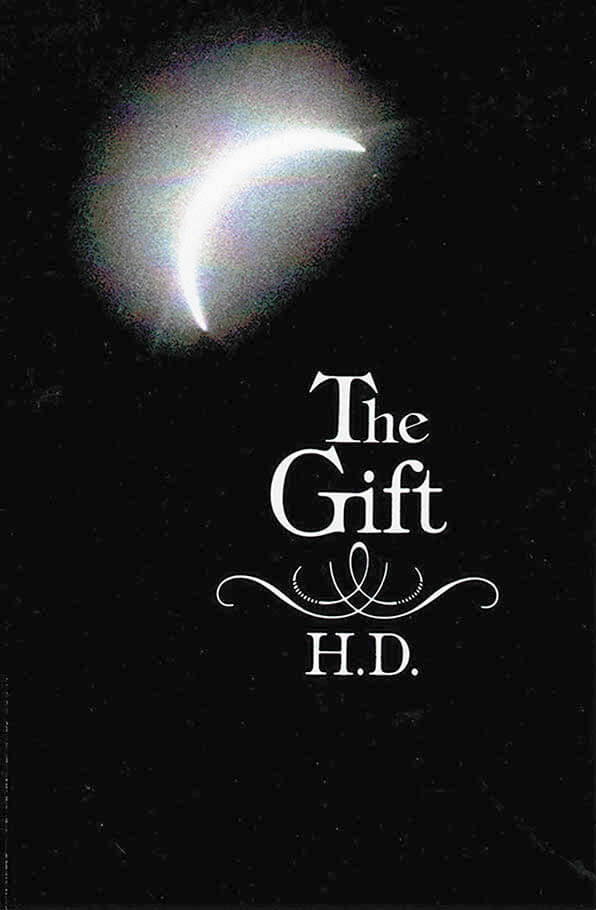
The Gift
The connections and interconnections of past and present––the realization that life is a whole continuously echoing back to the past and unfolding toward the future––were sources of the strength, renewal, and joy celebrated in H.D.’s Trilogy and, in a differing, but no less real way, in The Gift––her novelistic memoir of childhood. In recapturing her memories of being a very little girl in Bethlehem, Pennsylvania, and later on a country place outside Philadelphia, H.D. “let the story tell itself or the child tell it.” It is this voice or child’s-eye view that lends The Gift its special charm as H.D. recreates the ordinary and extraordinary occasions of her early youth, the nightmares and delights. A road-company presentation of Uncle Tom’s Cabin, Christmas Eve with its particular family ritual, a family outing, a disturbing accident––the happenings and incidents, perceptions and misconceptions with which a child’s life is crowded are the substance of this most winning book. As she did for the H.D. novel HERmione, H.D.’s daughter, Perdita Schaffner, provides a fine introduction.

Translation is a Mode = Translation is an Anti-neocolonial Mode
Don Mee Choi is the author of three books of poetry and hybrid essays, and an award-winning translator of contemporary Korean women’s poetry. In this pamphlet, Translation is a Mode=Translation is an Anti-neocolonial Mode, she explores translation and language in the context of US imperialism—through the eyes of a “foreigner;” a translator; a child in Timoka, the made-up city of Ingmar Bergman’s The Silence; a child from a neocolony.
This pamphlet is part of UDP’s 2020 Pamphlet Series: twenty commissioned essays on collective work, translation, performance, pedagogy, poetics, and small press publishing. Each offers a different approach to the pamphlet as a form of working in the present, an engagement at once sustained and ephemeral.
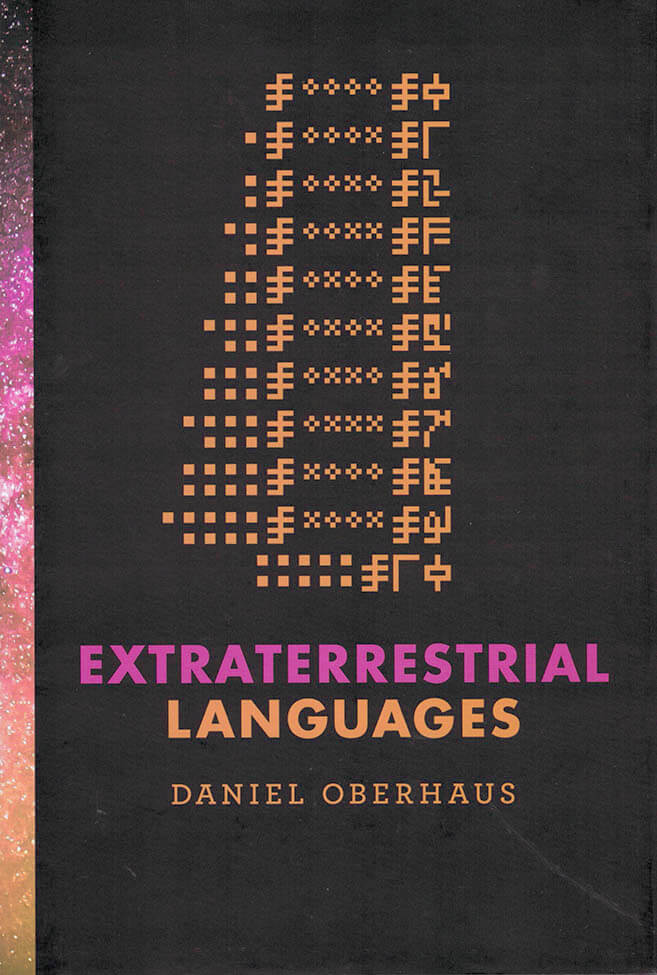
Extraterrestrial Languages
If we send a message into space, will extraterrestrial beings receive it? Will they understand?
The endlessly fascinating question of whether we are alone in the universe has always been accompanied by another, more complicated one: if there is extraterrestrial life, how would we communicate with it? In this book, Daniel Oberhaus leads readers on a quest for extraterrestrial communication. Exploring Earthlings' various attempts to reach out to non-Earthlings over the centuries, he poses some not entirely answerable questions: If we send a message into space, will extraterrestrial beings receive it? Will they understand? What languages will they (and we) speak? Is there not only a universal grammar (as Noam Chomsky has posited), but also a grammar of the universe?
Oberhaus describes, among other things, a late-nineteenth-century idea to communicate with Martians via Morse code and mirrors; the emergence in the twentieth century of SETI (the search for extraterrestrial intelligence), CETI (communication with extraterrestrial intelligence), and finally METI (messaging extraterrestrial intelligence); the one-way space voyage of Ella, an artificial intelligence agent that can play cards, tell fortunes, and recite poetry; and the launching of a theremin concert for aliens. He considers media used in attempts at extraterrestrial communication, from microwave systems to plaques on spacecrafts to formal logic, and discusses attempts to formulate a language for our message, including the Astraglossa and two generations of Lincos (lingua cosmica).
The chosen medium for interstellar communication reveals much about the technological sophistication of the civilization that sends it, Oberhaus observes, but even more interesting is the information embedded in the message itself. In Extraterrestrial Languages, he considers how philosophy, linguistics, mathematics, science, and art have informed the design or limited the effectiveness of our interstellar messaging.

Inflamed Invisible
A rich collection of essays tracing the relationship between art and sound.
In the 1970s David Toop became preoccupied with the possibility that music was no longer bounded by formalities of audience: the clapping, the booing, the short attention span, the demand for instant gratification. Considering sound and listening as foundational practices in themselves leads music into a thrilling new territory: stretched time, wilderness, video monitors, singing sculptures, weather, meditations, vibration and the interior resonance of objects, interspecies communications, instructional texts, silent actions, and performance art.
Toop sought to document the originality and unfamiliarity of this work from his perspective as a practitioner and writer. The challenge was to do so without being drawn back into the domain of music while still acknowledging the vitality and hybridity of twentieth-century musics as they moved toward art galleries, museums, and site-specificity. Toop focused on practitioners, whose stories are as compelling as the theoretical and abstract implications of their works.
Inflamed Invisible collects more than four decades of David Toop's essays, reviews, interviews, and experimental texts, drawing us into the company of artists and their concerns, not forgetting the quieter, unsung voices. The volume is an offering, an exploration of strata of sound that are the crossing points of sensory, intellectual, and philosophical preoccupations, layers through which objects, thoughts and air itself come alive as the inflamed invisible.